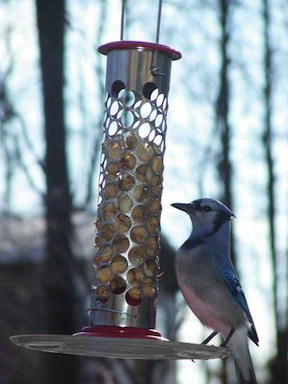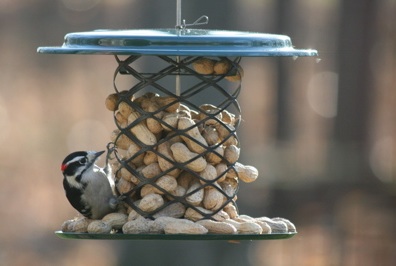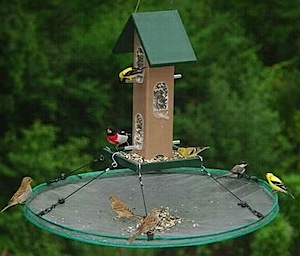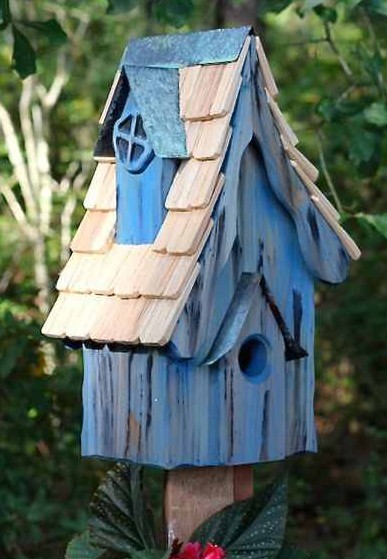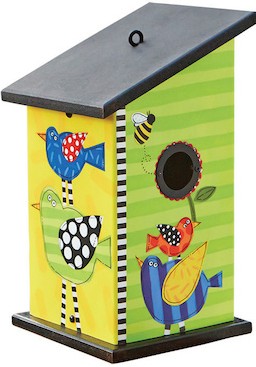-
Whole or Shelled Nuts for Peanut Bird Feeders?
Depends on who you’re looking to attract? Most clinging birds covet shelled peanuts, in fact almost all birds will go for them. But not all birds are clingers, classified by their ability to grasp a small surface (and their strong feet). Chickadees, nuthatches, woodpeckers and titmice for the most part are considered clingers. The term not to be confused with clingons from Star-Trek 🙂
Adding a tray to peanut bird feeders allows other birds to easily get the goods. Jays adore peanuts, warblers go for them in winter, as will most backyard birds during frigid weather. The tray is inviting, making landing and eating easier.
Larger trays even catch waste from whole peanuts, which folks who could do without the waste might find more appealing. Although when feeding shelled peanuts… there’s really not much waste all. So that alone may influence what’s best to offer at your place! Many shelled peanut feeders offer tray options-but should they not- a universal seed catcher is available to accommodate them.
If the waste from feeding birds is a big drawback, large adjustable seed
trays could be the answer. Attaching to almost any type of feeder, the large 16- or 30-inch diameter promises to catch anything that falls from the feeder. These also create a new feeding space with their large platform area. Peanuts pack a real punch in terms of nutritional value, especially in cold weather. They’re economical if purchased in bulk too. So don’t give up the ship due to the mess some peanut bird feeders may leave behind!
-
Don’t Let Sparrows Nest in Blue Bird Houses
Not all blue bird houses are created equal!
Depending on how much you’re willing to commit may play a part in choosing a house to host bluebirds. If you’re more of the “set it & forget it” kind (and that’s okay) at least use a quality wood or vinyl birdhouse. These usually have proper drainage, decent ventilation, adequate floor space and proportional entries (1.5 inches for Eastern blues and 1-9/16 inch for mountain and Western species).
Metal decorative houses really aren’t the best choice, especially since bluebirds (and some other species) tend to have 2-3 clutches or broods per season. During hot summer days… metal heats up and babies can fry 🙁
Predator guards are always helpful, both on the entry to keep grabby paws and larger bully birds out, and on the pole itself – in the form of a baffle. If the birdhouse hangs, simply use a hanging squirrel baffle above for further protection from predators.
The National Bluebird Society approves housing that is monitor-friendly, meaning you can easily access inside to see how the nest is progressing and babies are faring. Most bluebird specific houses have side doors for viewing, Gilbertson houses pop on & off of the roof via two pins, and the popular Peterson style has a front door that pulls down for nest checks. Seasoned bluebird monitors all have their favorites for different reasons!
But why would anyone want to see how the nest is progressing? House sparrows… they mustn’t be allowed to nest if you’re trying to attract bluebirds. They’re enemies, brutal enemies of native bluebirds. Until one witnesses the carnage- it’s difficult to grasp, and although native- house wrens should be deterred as well. The other day I was screaming at starlings in the yard when my friend insisted “they’re birds too-they deserve to eat.” Not here, nope, no can do! Also non-native, and invasive, they compete for nesting space with brutal tactics, not to mention the mess on every baffle and feeder around the yard!
If you’re new to hosting bluebirds, nature will show both the pleasures and heartache she can bear. Knowing a few basics will have you on your way in no time! Watch for sparrow nests, usually piled high and messy, with bits of trash woven throughout. They tend to have a tunnel-type entrance as well. House wrens will lay claim by placing sticks inside, criss-crossed, piled up twigs. They’ll do this even when not using the birdhouse to nest… but simply to keep others out of their territory. The website Sialis.org has a wealth of knowledge on identifying nests, eggs, behaviors and everything pertinent to bluebirds and other native cavity dwelling birds. Definitely worth a look!

